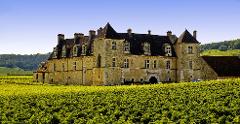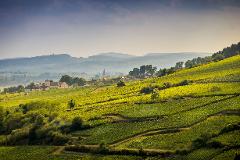Explore Beaune's Medieval Heart & Hospices de Beaune: Private Tour

- Duração: 2 Horas (Aproximadamente)
- Localização: Beaune
Follow a private guided walking tour with a licensed guide, expert of the town of Beaune. Today, we will come and pick you up at your hotel or accommodation in Beaune. If you are traveling from outside the city, we will pre-program a centrally located meeting point.
Meet your English speaking licensed guide who is accredited to conduct guided tours in historical towns, museums and monuments and thanks to the fascinating stories and local anecdotes you will discover Beaune in a fun & informative way.
Then, begin your 2-hour guided walking tour in Beaune. Discover how the city was built from the middle ages to the present day and admire the heritage which reminds us of the great Beaune Hours including the Notre Dame Collegiate Church and passing by the ramparts of the city.
A bit of History
The origin of the town of Beaune can be dated back to the 1st century BP when the Romans decided to build a fortification that lied at the crossroads between two of their most important ways. One linked the town of Lyon to Trier (Germany) and the other linked the town of Besançon to Autun. The town became prosperous in the 12th century thanks to the wine trade and its urban area expands outside the castle walls, erecting remparts that can be still seen today.
The town was at the time the Capital of the Duchy of Burgundy and the first Burgundian Parliament met at Beaune in 1227. During the middle ages, the town then organized itself around three major locations: the market square (that is today Place de la Halle), the Collegiate Church of Notre Dame (the old historical town center) and Place Carnot where the Parish Church used to stand.
The streets of Beaune have kept a number of houses and buildings that date back to those days, from Romanesque houses to 18th century private mansions. The town's past is also closely linked with religious life. Other than the Romanesque Clunisien style Collegiate Church of Notre Dame that dates back to the 12th & 13th century, a number of Abbeys and Convents still occupy a large proportion of the urban space.
Today, most of the buildings belong to wine merchants who have found an ideal location to store their wines. The Hospitaliers religious order also left their print in the town of Beaune with the most famous construction being the Hôtel-Dieu, built in a Franco-flemish style, and that dates back to the 15th century. There is a second Hôtel-Dieu named Hospice de la Charité that is a good example of 17th century architecture.
Hotel Dieu des Hospices de Beaune
The Hôtel-Dieu was a medieval hospital that featured vast halls for beds for the sick. Founded in 1443, the Hôtel-Dieu in Beaune is a two-storied construction that occupies three sides of a courtyard. In one of its wards is a Museum dedicated to Rogier Van der Weyden's great Altarpiece - The Last Judgement that was commissioned by Nicolas Rolin, the last chancellor of the Burgundian Dukes and the hospital's builder.
The Hospital was built to help the persons who had suffered from famine and poverty after the Hundred Years War. As you visit, discover the kitchen, the pharmacy and the vast hall with its wooden beds and red curtains that maintain some kind of privacy. The Hospices is also famous for the wine auction it organizes each year with wine produced from 53 hectares of vineyards that were donated to the hospital through the centuries. This Charity Sale is held every year in November.
Basilique Notre Dame
Beaune, located on the way to Jerusalem, was a popular stop for all the pilgrims wanting to make their way towards the Holy Land. Because the number of pilgrims that pass through the town in the 12th century is considerable, the Dukes of Burgundy decided to build a larger Church than the existing one, dedicated to the Virgin Mary. The beginning of the construction of Notre Dame Collegiate Church dates back to the second half of the 12th century. The architectural style of the Basilica was inspired by that of Cluny. The largest part of the Basilica is in the Romanesque style.
This sanctuary has kept rich furniture ranging from the Romanesque period to the 17th century. There are also important remains of 15th century wall paintings that you will discover during your visit. Notre-Dame de Beaune is known worldwide for its tapestries depicting Virgin Mary’s life; they are presented in the Basilica’s Choir.
This exceptional collection dates from the 16th century. The major events in Mary’s life are evoked in successive scenes. This set of tapestries was restored by the Hôtel-Dieu de Beaune’s nuns in 1852.
Grosse Tour
Beaune is a fortified town located in the heart of the prestigious Burgundy wine region. One of the four towers built in the early 16th century, it is decorated on the boulevard side with the coat of arms of the governor of Burgundy, La Trémouille. It played a role in monitoring the plain by watching the Route de Verdun, the nearby Saone forming the frontier between the French kingdom and the Holy Roman Empire until 1678.
Thus the guard saw the arrival in 1569 of the 40,000 Germans answering Condé's call, and then in 1636 the army led by Gallas that ravaged, pillaged and set fire to the faubourgs. Purchased in 1891 by the Maison Calvet from Bordeaux, it was used by this wine merchant as a prestigious tasting room before being acquired by the municipality. Its roof is laid out as a pleasure garden.
Wine tasting Burgundy Wine in Beaune
Beaune is considered to be the Capital of Burgundy wines. If you would like to taste some wines as part of this guided walking tour, it is possible for us to organize a wine tasting session in one of the numerous wine cellars that are located within the town of Beaune. During a commented session, taste some of the most typical local red and whites wines that have made Burgundy such a famous wine region of France.








